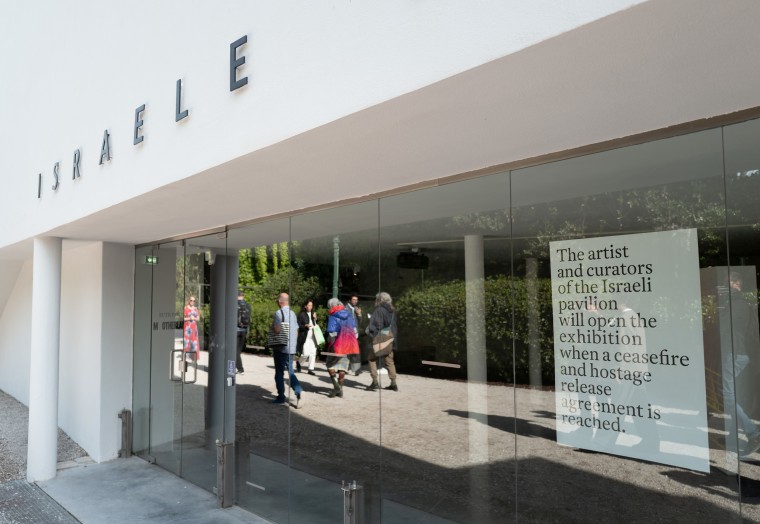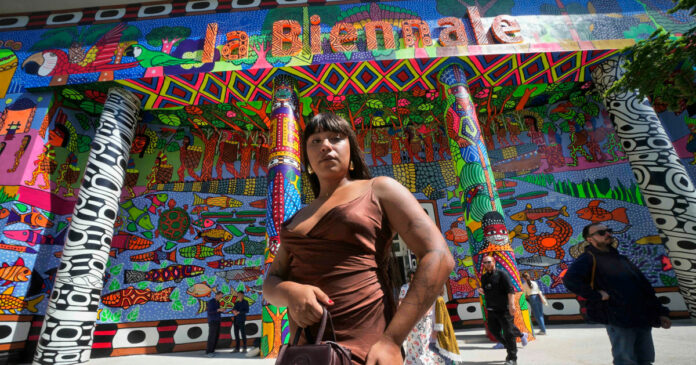VENICE, Italy — Outsider, queer and Indigenous artists are getting an overdue platform at the 60th Venice Biennale contemporary art exhibition that opened Saturday, curated for the first time by a Latin American.
Brazilian curator Adriano Pedrosa’s main show, which accompanies 88 national pavilions for the seven-month run, is strong on figurative painting, with fewer installations than recent editions. A preponderance of artists are from the Global South, long overlooked by the mainstream art world circuits. Many are dead. Frida Kahlo, for example, is making her first appearance at the Venice Biennale. Her 1949 painting “Diego and I” hangs alongside one by her husband and fellow artist, Diego Rivera.
Despite their lower numbers, living artists have “a much stronger physical presence in the exhibition,” Pedrosa said, with each either showing one large-scale work, or a collection of smaller works. The vast majority are making their Venice Biennale debut.
Visitors to the two main venues, the Giardini and the Arsenale, will be greeted by a neon sign by the conceptual art cooperative Claire Fontaine with the exhibition’s title: “Stranieri Ovunque — Foreigners Everywhere.” A total of 60 in different languages hang throughout the venues.
When taken in the context of global conflicts and hardening borders, the title seems a provocation against intransigent governments — at the very least a prod to consider our shared humanity. Through artists with underrepresented perspectives, the exhibition address themes of migration and the nature of diaspora as well as indigeneity and the role of craft.
“Foreigners everywhere, the expression has many meanings,’’ Pedrosa said. “One could say that wherever you go, wherever you are, you are always surrounded by foreigners. … And then in a more personal, perhaps psychoanalytic subjective dimension, wherever you go, you are also a foreigner, deep down inside.”
“Refugee, the foreigner, the queer, the outsider and the Indigenous, these are the … subjects of interest in the exhibition,’’ he said.
Some highlights from the Venice Biennale, which runs through Nov. 26:
Geopolitics at the Biennale
Facing the threat of protests, the Israel Pavilion stayed closed after the artist and curators refused to open until there is a cease-fire in Gaza and the Israeli hostages taken by Hamas -led militants are released.

Ukraine is making its second Biennale art appearance as a country under invasion; soft diplomacy aimed at keeping the world focused on the war. Russia has not appeared at the Biennale since the Ukraine invasion began, but this time its historic 110-year-old building in the Giardini is on loan to Bolivia.
For a short time during this week’s previews, a printed sign hung on the Accademia Bridge labeling Iran a “murderous terrorist regime,” declaring “the Iranian people want freedom & peace.” The venue for the Iranian pavilion was nearby, but there was no sign of activity. The Biennale said it would open Sunday — two days after the departure from Italy of Group of Seven foreign ministers who warned Iran of sanctions for escalating violence against Israel.
Golden Lions
The Golden Lion for best national pavilion went to Australia for Archie Moore’s installation “kith and kin,” tracing his own Aboriginal relations over 65,000 years. It’s written in chalk on the pavilion’s dark walls and ceiling and took months to complete. The Mataaho Collective from New Zealand won the Golden Lion for the best participant in Pedrosa’s main show, for their installation inspired by Maori weaving that crisscrosses the gallery space, casting a pattern of shadows and interrogating interconnectedness.


